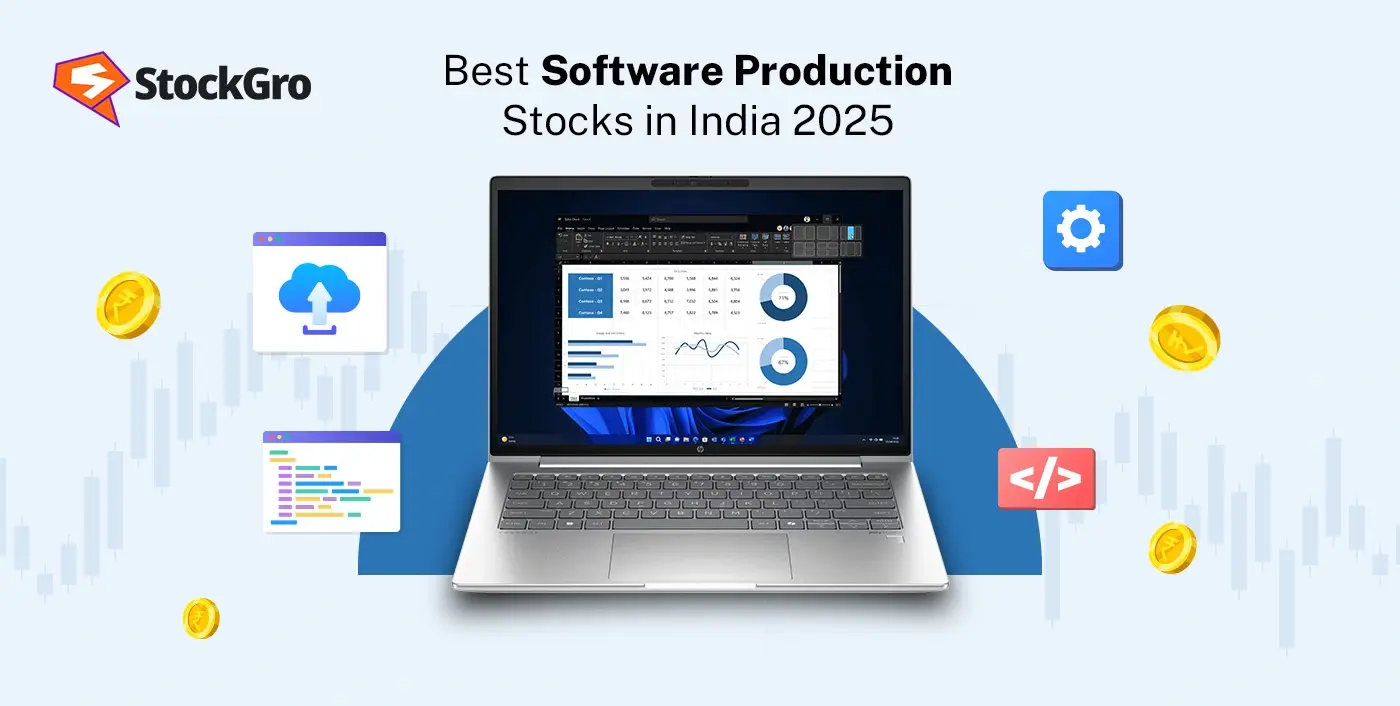
India’s stock broking industry has seen very growth in the recent few years. The total market capitalisation of all listed companies on Bombay Stock Exchange is reported around USD 4.8 trillion as of February 2025. This surge is largely driven by rising retail investor participation, fueled by greater financial awareness. Demat accounts have jumped from 4 crore in 2020 to 14 crore in 2024.
In 2025, several stock broking companies have established a strong presence with solid performance and growth potential. This blog takes a look at some of the leading stock broking stocks in India in 2025.
Also Read: Online vs Offline Stock Market Courses: Which Is Right for You?
Which are the best stock-broking stocks
Let us have a look at a few best financial sector stocks based on market capitalisation as of 11 April 2025.
| Company | Market Cap (₹ Cr) | Current Market Price (₹) | Price-to-Earnings Ratio | Dividend Yield (%) | ROE (%) | Promoter Holding (%) |
| Motilal Oswal Financial Services Ltd | 36,330 | 606 | 11.0 | 0.82% | 32.60% | 68.70% |
| ICICI Securities Ltd | 29,149 | 896 | 13.9 | 3.24% | 50.10% | 74.40% |
| Angel One Ltd | 20,452 | 2,265 | 15.3 | 1.53% | 43.30% | 35.60% |
| Nuvama Wealth Management Ltd | 19,837 | 5,514 | 21.8 | 2.62% | 24.30% | 54.90% |
| Prudent Corporate Advisory Services Ltd | 9,358 | 2,260 | 49.6 | 0.09% | 33.40% | 55.70% |
(As of 11 April 2025)
1. Motilal Oswal Financial Services Ltd
Motilal Oswal is one of the leading firms which is engaged in the business of financial services, and the company is very aggressively growing its business by having its presence in more than 550 cities.
| Metrics (In ₹ Crore) | FY21 | FY22 | FY23 | FY24 | 9MFY25 |
| Sales | 3,626 | 4,298 | 4,178 | 7,069 | 7,149 |
| Operating Profit | 2,016 | 2,120 | 1,877 | 4,067 | 4,272 |
| Net profit | 1,260 | 1,310 | 932 | 2,441 | 2,566 |
| EPS (In ₹) | 21.49 | 21.97 | 15.74 | 40.96 | 55.03 |
The company’s revenue increased by 11.6% year on year, reaching ₹1,998.63 crore for the Q3FY25, with operating margins in the range of 53% and net profit of ₹564.52 crore.
The company’s AUM has reached ₹6 lakh crore as of Q3FY25, which has increased at a CAGR of 38% since March 2024. In the lending business, the lending increased to ₹12,254 crore, up by 44% year on year, reaching ₹12,254 crore.
2. ICICI Securities Ltd
ICICI Securities Ltd is engaged in the business of broking, where they are present on both retail as well as institutional side and provide various financial products distribution.
| Metrics (In ₹ Crore) | FY21 | FY22 | FY23 | FY24 | 9MFY25 |
| Sales | 2,586 | 3,435 | 3,422 | 5,049 | 6,476 |
| Operating Profit | 1,593 | 2,185 | 2,109 | 3,372 | 4,551 |
| Net profit | 1,068 | 1,383 | 1,118 | 1,697 | 2,097 |
| EPS (In ₹) | 33.14 | 42.84 | 34.61 | 52.46 | 55.03 |
The company reported a revenue of ₹1,585 crore for Q3FY25, making a year-on-year growth of 19.9%. The operating profit margin was 74%, and net profit was ₹504 crore.
Also Read: How to Select the Best Long-Term Stocks for a Secure Financial Future
3. Angel One Ltd
Angel One Ltd is a broking firm that is engaged in the equity segment and the commodity-currency segment. Moreover, they also have other products like mutual funds, derivatives, futures, etc.
| Metrics (In ₹ Crore) | FY21 | FY22 | FY23 | FY24 | 9MFY25 |
| Sales | 1,289 | 2,292 | 3,002 | 4,272 | 4,182 |
| Operating Profit | 460 | 926 | 1,294 | 1,693 | 1,638 |
| Net profit | 297 | 625 | 890 | 1,126 | 998 |
| EPS (In ₹) | 36.29 | 75.37 | 106.71 | 133.99 | 151.00 |
For Q3FY25, the company’s revenue rose 19.2% year-on-year, reaching ₹1,262.21 crore, with operating margins at 39% and net profit of ₹28 crore.
The company was also able to improve and increase its market share to 15.9%, and they have added around 2.1 million clients to trade on its portal.
4. Nuvama Wealth Management Ltd
Numava Wealth was incorporated in the year 1993, and it is a broking firm which is also registered as an investment advisor and is engaged in the merchant banking segment.
| Metrics (In ₹ Crore) | FY21 | FY22 | FY23 | FY24 | 9MFY25 |
| Sales | 1,384 | 1,778 | 2,223 | 3,156 | 3,033 |
| Operating Profit | 445 | 646 | 883 | 1,565 | 1,635 |
| Net profit | -475 | 857 | 305 | 625 | 731 |
| EPS (In ₹) | -136.78 | 246.90 | 87.03 | 177.14 | 256.00 |
During Q3FY25, the company’s revenue reached ₹3,032.6 crore, making a 22.7% year-on-year growth, and operating margins were reported at 56%, with profit at ₹730 crore.
The AUM grew to ₹1.3 lakh crore, and the market share for AIF and PMS of the company reached 22%. The company has also launched a commercial real estate fund targeting ₹3,000 crore.
5. Prudent Corporate Advisory Services Ltd
The company was incorporated in 2003, and the company provides various stock broking services along with third-party product offerings.
| Metrics (In ₹ Crore) | FY21 | FY22 | FY23 | FY24 | 9MFY25 |
| Sales | 295 | 458 | 617 | 823 | 821 |
| Operating Profit | 70 | 123 | 181 | 211 | 194 |
| Net profit | 45 | 80 | 117 | 139 | 144 |
| EPS (In ₹) | 453.00 | 19.41 | 28.19 | 33.51 | 45.50 |
The company had a revenue growth of 35.8%, and it reached ₹285 crore in Q3FY25, with operating margins in the range of 23% and a final profit of ₹48 crore.
The company is targeting SIP inflows worth ₹1,000 crore for the full year FY25, and the equity AUM of the company reached ₹1.02 lakh crore.
Bottomline
In India, growing awareness around financial planning has led to a shift, due to which people are investing in stock markets more in today’s time, rather than traditional investment options like FDs and savings accounts.
The trend seems to be rising with increasing SIP inflows in mutual funds, which have increased from USD 1 billion in 2020 to USD 1.93 billion in 2024, which is directly going to benefit this sector. Overall, the outlook for the broking sector appears positive, and companies in this space may have the potential to perform well.
Also Read: Why SEBI Registration Matters: How to Find Genuine Advisors for Investments
FAQs
1. What are the different types of broking companies?
In broking companies, there are various types like full-time brokers and discount brokers. Full-time brokers usually apply a certain brokerage cost to their clients, whereas discount brokers will not apply any brokerage to their clients. They usually have brokerage only on the derivatives and the F&O segment. On the other hand, full-time brokers will provide relationship manager services like call and trade, advisory, etc., so they charge a fee in the form of brokerage. Depending upon investors’ preference, they can opt for the brokers.
2. How do broking companies earn profit?
The main source of revenue for the broking firm is through brokerage. This brokerage is a kind of fee or commission that they apply on the buying and selling of securities. Apart from that, the broking firms also charge annual maintenance charges, which is a cost for maintaining the account with them, collected yearly or quarterly. The more clients the broking firm acquires and the more transactions they do, the broking firm’s profitability will be improved.
3. How are the broking companies regulated?
The broking companies in India are regulated by the government to protect the interests of the investors. In India, all the broking firms come under the Securities Exchange Board of India (SEBI). All companies have to work under the guidelines laid down by SEBI. There are continuous periodic audits conducted by SEBI to monitor the stock broking companies. They keep on bringing new rules and awareness measures for the investors so that they are not exploited, and this is for their betterment.
4. How do broking firms maintain liquidity in the bearish markets?
In the time of market downtrend, there is very high volatility and panic in the market. Brokerage firms often face liquidity risk in such times, which means that they may struggle to process high volumes of trade. This depends on the research and the fund management, and how they handle such things efficiently.
5. What is the role of broking firms in an IPO?
Brokerage companies play a very important role in the initial public offering of a company. They list the IPO on their platforms and this goes publicly live through advertisements, offering to investors. With this, proper marketing of the IPO is done so that the retail clients and the institutions are aware of the new IPO. The success of any IPO depends upon how well-known the broking company is.

